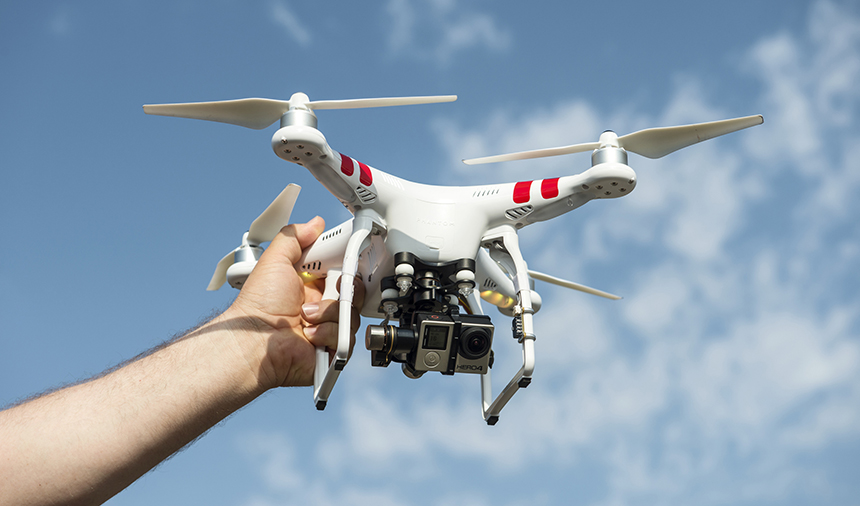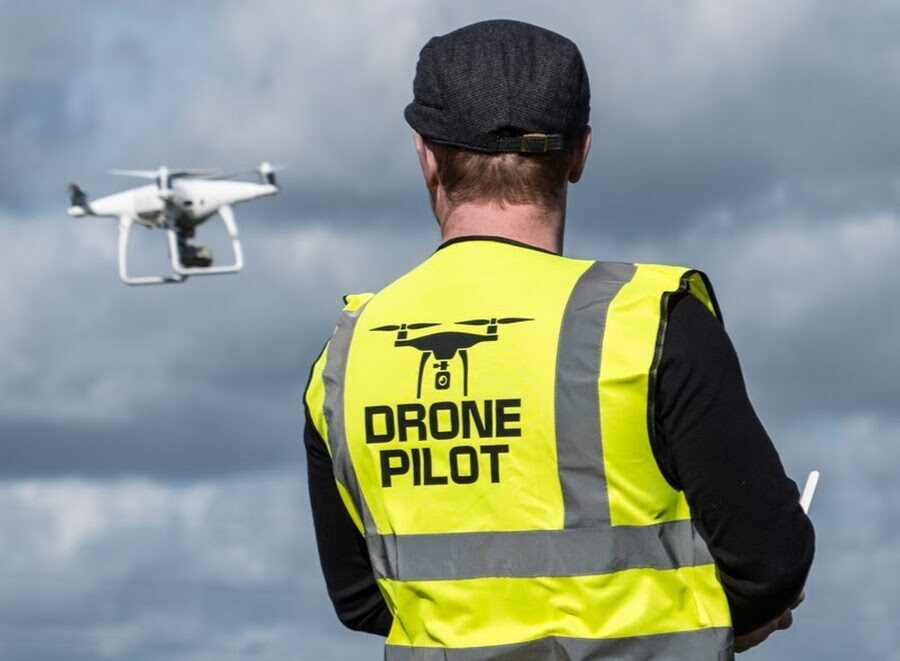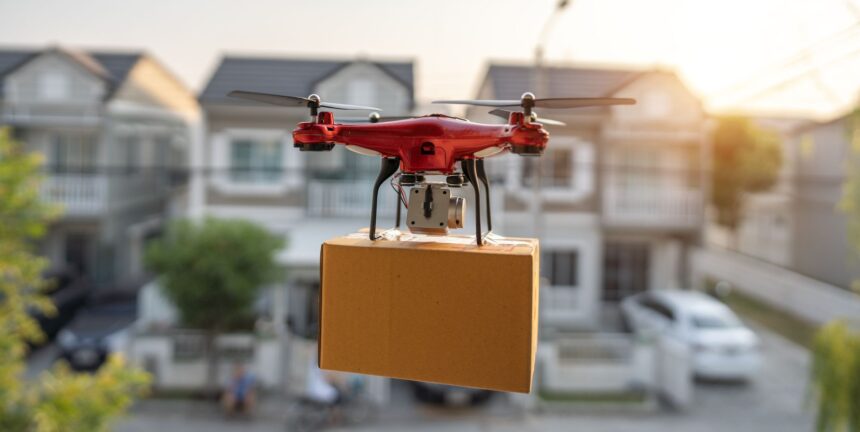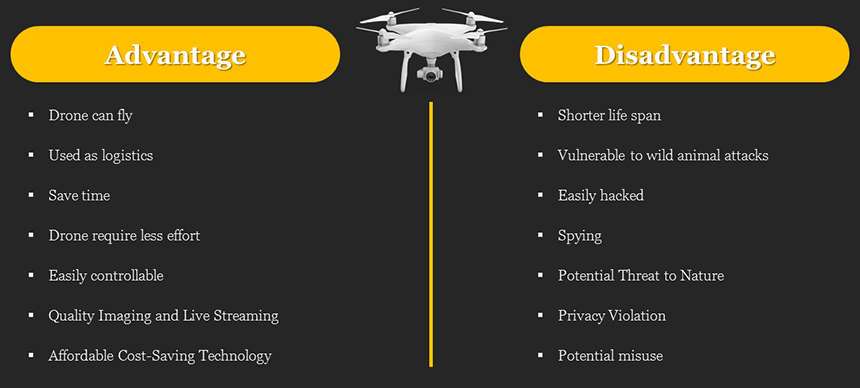If you’re thinking of buying a drone or simply learning more about them, a really good place to start is with drone pros and cons.
Drones have many great plus points, but in reality, they have downsides that simply have to be considered. Those downsides can be expensive if you aren’t aware of them. The pros of drones are also essential to understand because you may not yet realize how useful drones really are. Drones can even give you a new career path!
To help you learn more about drones, we have collected lots of information on drone pros and cons, plus extra information we know you’ll find helpful:

An unmanned aerial vehicle (UAV), commonly known as a drone, is an aircraft without any human pilot, crew or passengers on board.
A drone is something called a UAV, which stands for ‘unmanned aerial vehicle’. This term includes any type of aircraft that does not have a pilot used on the earth, or even in space. Drones are also called quadcopters, which means that they have four rotary blades, unlike a tricopter, which has three.
Drones can cost anything from under $100 dollars to thousands of dollars, depending on the technology you need or want. By understanding the advantages and disadvantages of drones, you can get an idea of what you might want from one, what to look for and how much that might cost.
If you’re thinking about buying a drone or simply want to know more about them, it is a good idea to know about drone pros and cons. There is a lot of great press about drones at the moment, but there are some downsides to them. Knowing those downsides so that you can keep them in mind when buying a drone as a gift, work around them, prepare for them or simply stay inside the law is very important.
Overall, because drones are such a new device and are changing so quickly, drone pros and cons change all the time.
Hopefully, the best technology will become more affordable. Laws will be made to protect animals, buildings, and people from drones whilst enabling the technology to boost various aspects of the industry, medicine, and conservation. In the meantime, if you’re looking to buy a drone for fun, you can buy some incredible models for a reasonable price. For professional use, a little more care and research are needed to ensure you get the best drone for the job and all the correct licensing and training required to make the most of your purchase.
At a glance, here are the main drone pros and cons for you to consider:
|
Pros |
Cons |
|
|
Drones are a lot of fun to fly and really push far beyond remote-controlled aeroplanes and other hobbyist flight toys. Seeing your own drone do aerial acrobatics and tricks is truly pleasurable, and anyone from young children to grandparents will smile seeing what their airborne toy is able to do.
Beyond general use, many drone flyers enjoy entering competitions, meeting other drone users at events, and generally getting involved in the world of drones. Drone use is an entire community now.
Many drones have automated flight modes and carry good cameras and gimbals on them. This means that today’s selfie market can truly embrace the drone in its selfie shots. From incredible aerial videos of you sunbathing on a beach to cool and creative flying intros to vlogs – there’s a ton of fun to be had with drones when it comes to social media photography and videography.
Quadcopters use extremely simple systems, which means that even beginners can have their drone up and fly very quickly. The operations keep getting easier and easier too, so everyone can get the most out of their drone.
Drones are really useful hobby items that boost other hobbies. With fishing, for example, drones are useful for identifying currents, schools of fish, or areas where big game fish are active. If you take a look at the best drones for fishing, there are multiple options because so many people are already using drones for this reason. Various hobbies, like photography, hunting, fishing, and even surfing, can benefit from using drones.

Drone piloting can be a well-paying profession. It’s a rapidly expanding vocation that’s playing a larger and larger role in many industries.
You can now get a drone degree, and multiple careers are available for drone operatives. From surveyors who use drones to get detailed results to filmographies offering drone footage for video production companies, there are so many chances to get ahead in your career by mastering the drone.
If you’re looking for the best drone for filmography, the DJI Mavic Air 2 is favored by experts as a good mid-range choice, namely because of the 4K video, gimbal, and 48MP camera, and the phenomenal 8K hyper-lapse option.
You don’t have to base your career on drone footage alone, though, as simply adding it to your list of skills can boost your career opportunities. Wedding photographers, for example, are checking out the best drones for wedding photography in order to offer a USP to gain more clients. Drone flying and use is a great CV boost for many careers, so it is worth considering if you want to boost your chance of getting hired (depending on the industry you work in).
Drone pros and cons often address the expense of drones.
Drones can cost a lot of money, but they don’t have to. There are plenty of fantastic drones to meet every budget, many of which can be found for under $200. For example, the Holy Stone HS510 GPS Drone comes in under 200 dollars, and yet it has features you would expect from a much more expensive drone, such as a 4K video. You can also consider tricopters as well as quadcopters if you want to diversify your search. Tricopters have three rotary blades instead of four, like quadcopters, and they tend to be lighter and slower than a traditional drone. They can also be purchased exceptionally cheaply, so they can be a good choice for beginners willing to put the time into controlling them well.
When it comes to drone pros and cons, the considerations go far beyond hobby use.
Most businesses can benefit from drone use: from more direct applications like delivery offering retail a quicker, cheaper way to get products to customers to more additional support, like better marketing from the use of aerial shots. There is a way for every business to benefit from drones in some shape or form, and the chances are companies in the future will either utilize them within their own infrastructure or outsource them to boost operations and brand growth.
When it comes to the use of drones in various capacities instead of manned aircraft, drones are always cheaper and easier to use. Rather than using two people flying a police helicopter to track a criminal, it is easier, quicker, and more affordable to have an infrared drone deployed. Or, when drones are used to transport emergency items, the time and money involved are much cheaper than a helicopter or a plane.
Because of the clearance, money, and effort involved in manned crafts, if drones can be used instead, they are almost always the better option, so you can expect to see them used more in replacement of manned crafts in the near future.
From the best drones to survey a roof to drones with infra-red for tracking criminals, drones can reach places that we may struggle to get to, which tends to be a huge pro when we look at the disadvantages and advantages of drones.
Even if we can reach certain places, drones can also get there more quietly, cheaply, and with minimal physical destruction. This is a huge pro of drones, particularly in industry or conservation, where human resources are simply not the job’s best tool.
Whilst many people can be impressed by the sight of a drone, some people are really anxious, wary, or even angry when they have a drone flying around them. It isn’t uncommon to hear about drones being hit out of the sky by various things as people feel the drone has infringed on their privacy or security. Of all drone pros and cons, the fact that drones are still very scary to some people is a big con as it can affect how and where we use them.
As drones can get everywhere and anywhere, they come with all kinds of privacy problems. From viewing people in their bedrooms to accidentally encroaching on properties previously protected by walling and ground-level security, the privacy of pretty much, everyone is at risk with drones. With the advantages and disadvantages of drones, governments are aware of the issue of drone privacy, and it is being considered regularly, which is definitely a plus point if you are concerned about drones and your own privacy.
Drones are very lightweight and easy to fly, but they can still be poorly driven, be affected by weather, hit a bird, or simply malfunction. For that reason, a drone can potentially cause damage and people damage, and many close calls have been reported, but no fatalities at this point. Here are some examples of drone damage close calls:
When it comes to drone pros and cons, the cons of drones and their danger to humans is something we will see more and more of in headlines as society adjusts to this new technology type.
The laws on drone use are different in every country, and they are constantly changing. The reason for this is to keep up with the technology and changing uses for these types of air vehicles. While it is a good thing that the laws are entirely tailored to meet the safety demands of drones, it can be expensive and challenging to keep up with those laws as a hobbyist and especially as a professional drone user.
While many excellent drones are available at competitive prices, the very best drone technology is inaccessible to most budgets. Many of the top drones cost at least $5,000, and some go beyond $15,000, not to mention any licensing and piloting you have to pay for as well.
As it stands, you have to make a serious investment for the best drone technology, although, as with all technology, those prices should reduce in the future.
In some areas, it is entirely illegal to fly drones at all. You may assume areas where it is unsafe to fly drones, like airports, are the main places where strict limitations exist, but it can simply be the land owner’s choice. In the UK, the National Trust bans the use of drones on its land unless qualifications and a license granted by the trust are issued. Various organizations across the board in the UK, America and other countries are following suit for multiple reasons, which can be problematic depending on where you want to fly your drone.
There is currently a huge issue with drones disturbing animals previously unreachable by other means.
For example, cliff birds like seagulls, cormorants, and gannets take refuge away from humans and other predators.
Grey seals, common in the UK, shore up to give birth and rest. If drones disturb them, they can do something called a ‘stampede’ where they quickly move from the beach into the water. In doing so, they can injure themselves, and if this happens regularly, they may abandon pups or not gain enough weight to support pups they have during pup season.
To make the most of a drone beyond fun uses, you do need training which can be costly and time-consuming in addition to the cost of the drone itself.
Some people worry that crowded skies will be an issue in the future. With satellites, drones, potential flying cars, and more, it is a real potential downside that our skies become full in the future because of drones and other flying vehicles. Of course, this is an issue many of us are unlikely to see come to fruition in our lifetimes when it comes to drone pros and cons.
Although it is rare, drones have been used to compromise some people’s privacy with journalism and photography that would have otherwise been impossible because of walls and other security protocols. While this use is worrying, it isn’t as scary as some have concerns for drone use in the future.
Some people worry that drones open the door for unmanned flight weaponry and other malicious use such as terrorism.
From Sophia the robot Trusted Source Meet Sophia, the Robot That Looks Almost Human | National Geographic Rubberized faces stretch into familiar shapes, driven by tiny motors and a distant version of artificial intelligence—is this the future? www.nationalgeographic.com to Twitch streaming robots Trusted Source The Robotic Influencers of our Future: A Minecraft-playing, Twitch-streaming Robot | Towards Data Science The robot was created as part of Futurice’s project with Yle, the national broadcast company of Finland. towardsdatascience.com , there is no doubt that technology is advancing towards truly impressive artificial intelligence much faster than any of us may have predicted. It can be a scary thought, but the reality is that robot technology will help us rather than ‘take over the human race’ or similar sci-fi storylines.
Kate Swanson, roboticist and robot ethicist, discusses in her latest book how we may come to think about some types of robots like animals in the future, in that they have a different kind of intelligence, societal use to us, and correct way of being treated fairly. Despite this perspective, which suggests a supplemental service from robots, you’d be forgiven for feeling a touch unnerved if you have seen any media from robot leader Boston Dynamics.
Drones, though, are not robots, but they fall into a similar category of advanced technology that has the potential to change the world. It is a dynamic industry that has already made huge changes to multiple industries, including:
Livestock is tracked, managed, and even moved using drones. Crop health and field health are tracked using drones, and in the future, crops may even be partially managed by drones.
Ecological areas of special interest, particular ecosystems, endangered animals, and seagrass, forest, and jungle systems, are being monitored by drones in the regions that may be otherwise difficult to survey in vehicles or on foot.

The drone takes off vertically, flies to the package pickup spot, hovers about 23 feet off the ground and uses a winch to lower a specialized hook.
There are trial drone delivery systems, but it remains much of a novelty. However, the chances are that deliveries in the future may well be dominated by drone services rather than human delivery.
From police drones to general security checks, drones are already incredibly useful in surveying areas that cannot be adequately checked or quickly enough on foot or by vehicles.
The film and photography industries have already seen a considerable impact from drone technology, with many incredible shots being achieved by drones. This area is likely to see a lot of drone use within the next few years, in particular news channels taking advantage of breaking news shots from a different angle.
Rather than lorries moving items between different factories and warehouses, drones will be able to do this in the future. Currently, the weight capacity of drones, along with their battery life, is not suitable for this use, but it is likely to happen in the future.
Finding mines, searching out enemy insurgents, performing targeted attacks, surveillance, and moving weapons safely are just some uses for drones by the military. The drone technology they have is top secret, but it doesn’t take much consideration to understand exactly how much use they might have for the military in the future.
Solar-powered drones are already being worked on as a way to get internet services to remote areas where masts might not be practical.
Surveys, aerial images for marketing, neighborhood snapshots, and more are already achievable with drones. In the future, drones will likely be used to create smooth videography and 3D marketing of homes and areas to further boost the marketing of a property. Surveys by drone will also help to go further than aged ordinance maps and property history.
NASA landed the Perseverance Rover on Mars on the 18th of February 2021. It took Ingenuity, a type of drone used to fly on Mars and gather further information on the red planet.
As you can see, drones have already changed the world, without even thinking too much about their potential for the future. Drone pros and cons are considerations for everybody because drones will become part of every industry and all of our lives in some way.
When it comes to the unknown future of drones, it is likely a reality that there will be special parking spaces created to accommodate drones that need to be docked for charging between their various uses. That means we will likely see physical adjustments to our world made directly because of drones.
All of the above industries are likely to continue to utilize drones in various ways, with a more fluid and agile approach to many tasks previously hindered by human or modern transport capabilities. We might be a way off seeing drones move around us (the public) performing various tasks because the safety and overall logistics are enormous. For that to happen, it is likely refined AI will form part of the process, controlling drones and drone flights in a much more refined and precise way than humans can ever achieve.
In the nearer future, we will see more drones being used by industries with a direct benefit to easier aerial access (compared to helicopters or planes). The film industry, journalism, agriculture, and the like, will all see quick beneficial changes from drones. Moving forward, there’s no real way to predict how drones will affect our future, but it is guaranteed that they will in many ways, and so their pros and cons will change over time.

The number of main advantages and disadvantages of the drone is approximately equal.
Drone pros and cons are important to consider as a drone enthusiast or potential drone owner. From the cost of a drone to its possible uses and ability to cause fear, harm, or damage, it is important to understand all aspects of these fantastic unmanned crafts to operate them responsibly and get the most out of them.
The question is, in which direction you will take your drone enthusiasm? Will you use them to help you fish? Will you take selfies with your drone? Will you use your drone to boost your career? The possibilities are endless, but by knowing the key drone pros and cons above, you’re much better informed to make a decision that’s right for you.